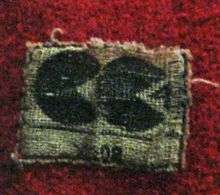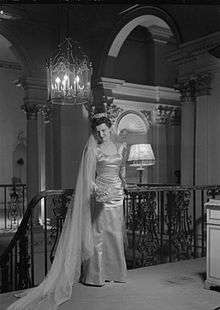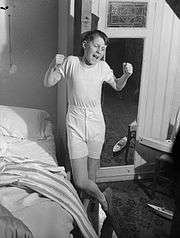CC41
The CC41 Utility logo was a British Board of Trade requirement that appeared on footwear, utility furniture, textiles and utility clothing for just over ten years from 1941. Per a 1941 Associated Press article, CC41 meant "Controlled Commodity",[1] and designated that the item met the government's austerity regulations.[2]


The CC41 logo was designed by Reginald Shipp.[3]
Historical background
The need to ration certain commodities in time of war had affected manufacturers in Britain during the First World War. In 1917 the government introduced 'standard clothing' which were suits for men and boys and women's and girls dresses and accessories (hosiery and underwear) made to a standard pattern from 'standard cloth'. All items had a fixed price. This range of clothing first appeared in the summer of 1918 but manufacturers complained they could not make a profit on the items, and the public complained of poor quality. With the war coming to a close in November 1918, the scheme was dropped as more imports again reached Britain.
Second World War

By 1941, Britain was two years into another global conflict. With the need to produce clothing and other war essentials for the expanding armed services during the Second World War, many items were once again rationed. Certain raw materials could no longer be imported, and those that could were directed towards the war effort. Food rationing had already been reintroduced in January 1940. Non-rationed items saw their price surge, and clothing saw large mark-ups in price, well above the cost of living.
The government introduced the Limitation of Supply Orders that forced manufacturers to produce only a fraction of their pre-war amounts. By April 1940, the limits on cloth were having a major impact with a 25% cut in wool and rayon, and a 75% in linen. As a consequence manufacturers ended the production of any loss-making lines which led to calls for clothing rationing to be introduced. The prime minister, Winston Churchill, believed that the general public would not accept this change.
In 1941, Oliver Lyttleton, the President of the Board of Trade managed to introduce clothing rationing. Churchill, although thankful the public accepted the move, replaced Lyttleton with Hugh Dalton (a Labour member of the coalition government since 1940) a month later. Churchill was fully aware that the necessary evils of rationing and conscription were now necessary as Britain became involved in a 'total war' spanning the globe.
Shortly after Dalton took office he appointed Metford Watkins as Director of Civilian Clothing as the Board of Trade. Watkins, aware of the high price of clothes at the time, promised to introduce cheaper clothes via 'austerity' provisions but not, as had been done during the First World War, using standardisation. Shortly after the government announced the production of 'national footwear'. The austerity provisions governed exactly what could or could not be used in the manufacture of clothes and shoes (for example, number of buttons, pleats or pockets, height of heels, amount of lace or embroidery, no turn-ups on trousers and no double-breasted suits).
With the introduction of purchase tax in October 1941, items were taxed at different rates and necessities were designated as tax-free. This stimulated production, reduced waste and through higher taxation curtailed the production of expensive clothing.
Utility items

Utility cloths were introduced and manufacturers were supplied with raw materials on a quota system. Manufacturers who agreed to increase production of Utility cloth would receive a higher quota. The public bought Utility clothing as it was tax-free.
By September 1942, 40 cloths had been specified (19 wool, 16 cotton, four rayon and one locknit) which all now utilised the CC41 Utility mark, designed for the Directorate of Civilian Clothing by Reginald Shipp.[3] Though the symbol was intended to mean nothing, the 'two cheeses' looked similar to CC and it was inferred they stood for Civilian Clothing (and not Controlled Cloth or Controlled Commodity).
The symbol was to appear on clothing, footwear and furniture and the single, identifiable mark quickly allowed the public to know if an item was tax-free or not. However, the system had some initial flaws as some items were poorly produced but with time these problems were removed. The symbol came to represent cheap, but reliable goods. Within the Utility footwear there were sometimes bands for quality difference. Ladies shoes would feature the Utility mark and either W1, W2 or W3 which had a different and increasing price range.
Post-war
Though the Conservatives had hoped to scrap the Utility system after the war, with the Labour victory in the 1945 general election, the scheme ran until 1952 (and was withdrawn following the Conservatives returning to government that year).
See also
References
- "Underwear Streamlined," Sept. 1941 Associated Press newspaper article
- "A Point of View: Dazzling in an age of austerity". BBC. 2011-12-31.
- "Utility Coat and Hat". V&A Museum of Childhood. Archived from the original on 2012-01-19. Retrieved 2012-01-01.